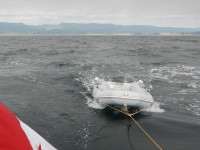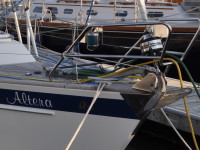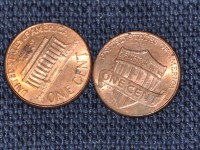The marine industry is full of gear, equipment and gadgets and I’ll be the first to admit I’m like a kid in a candy store in a marine chandlery. The challenge as a long range cruiser is you are often geographically unable to capitalize on warranties or make returns if gear doesn’t work because you have long since moved on. So, to anyone planning a cruise here is the gear that we have found to be less than stellar.
Our Navionics charts on our chart plotter were at times totally useless in the Bahamas. Now in fairness, they did show land in the correct places and if you stayed on the ocean side where it is hundreds of feet deep, no problem. But travel on the shallow banks, which is part of the joy of sailing the Bahamas as well as where you anchor at night and they are can be just plain wrong. Substantial Hazards missing or showing notable shoals that don’t exist, not a simple position offset that would be understandable. Other cruisers I met that have cruised the Bahamas extensively shared the same opinions.
Now I respect that that the survey data in the Bahamas is some of the oldest out there, so I didn’t expect the same level of detail and accuracy as busy ports in Canada and the US, however, the explorer chartbooks have compiled a great amount of survey detail for the areas people cruise. These are the gold standard and we are glad we bought the 3 chartbooks. Flip through a few pages and you will also find advertisements for every brand of electronic charts that have licensed the data in their own electronic charts. Seems to be everyone EXCEPT Navionics. I suppose they feel they have a big enough portion of the market share that they need not improve their product.

We primarily used the GPS to program waypoints from the paper guides in the Bahamas to assist with our navigation after finding the first few errors and omissions.
Outside of the Bahamas, the Navionics charts have been reliable thus far, and have agreed with paper charts for the areas we have cruised. But, I felt this needed to be said as many people enjoy the ICW trip down the coast and never intend to go beyond the Bahamas. If that describes your intentions, go with one of the competitors. Our Garmin BlueCharts on the iPad were in better agreement with what we saw in the Bahamas and better matched the Explorer charts, although there were still a few variances.
As for the Raymarine E7 we are generally happy, but have one complaint about the controls when you lock out or can’t use the touch screen (When a rain squall hits or you are getting a lot of spray in the cockpit going up wind, the screen gets wet and you have to use the manual buttons and knobs). The problem arises when you use the dual display mode with a chart and the radar. There is no manual button to change between screens so if the chart is selected and you need to zoom in on the radar it can’t be done and vice versa. Hopefully they will address it via a software upgrade following Chrissy’s suggestion to them.

Anchor shackles are a rather important piece of gear, at least in my opinion. Unfortunately I seem to be alone in this belief as all the marine chandlers in Canada seem to carry made in China shackles with no official load rating. I inquired why at a West Marine and was told ‘we have never had a customer complain of one breaking’. Great. So why on earth do they recommend high quality proof tested chain if we are just going to connect it to the anchor with a cheap shackle that is weaker than the chain and no known control on the manufacturing? Fortunately I found load rated shackles at Defender in the US and ordered a few that match the chain strength for a whopping dollar or two more than the questionable ones. Are sailors really that cheap on average that it isn’t worth chandleries stocking the real thing? I will concede that 99.9% of the time this probably doesn’t matter, but as a cruiser you never know when that 0.1% chance massive squall will come through.
Our Innova inflatable kayak hasn’t proven to be quite as durable as we’d hoped. We’ve had a number of small air leaks in the floor and patches just seem to slow it down, not fix it. Next we will try the liquid sealant that you put inside the air chamber. In fairness, this is probably the lightest, most compact inflatable kakak out there which allowed us to fit one aboard. Seeing as it is still useable and we have been glad to have one we would probably buy it again, .but if we had more stowage space we would go for a heavier more durable one.
Waterproof flashlights are a required piece of safety gear for the dinghy and kayak, but we haven’t found one that stands up. They all seem to get moisture in them and then rot out the electrical contacts. So far we have gone through the little one that came in a safety kit from Canadian Tire, one from Princeton Tec, and two others that came with Altera. I tried a Maglite for a little while as this was the only option I had to be legal for a few weeks, but even it had moisture in it a few weeks later so it too would eventually succumb to the same fate. Now I have a pair from West Marine that I got on clearance to hopefully get through a year. If anyone has a compact waterproof flashlight they are happy with that has stood up for a long time, I’d be glad to hear about it.
We bought a Navisafe dinghy light last summer so that we would be visible at night to those idiots that run around full speed in anchorages with no lights and probably half in the bag. This convenient little LED light has a magnetic base that mounts on the top of the outboard. Unfortunately the first one failed after a couple of months, notably after it got left in the dinghy overnight in a rainstorm, and of course 2000+ miles from where I bought it. I have been able to get it to work by jumpering the contacts on the circuit board so I know it is just the internal switch, but good luck finding the $0.10 switch and being able to solder it on…. Seeing as I had already drilled a hole in the outboard cover for the magnetic base, we bought a second one in the BVIs and it is still going strong, although we make sure it is stored inside Altera at all times except when we are using it. On the bright side, I now have 2 magnetic bases and could probably use the working one on low power setting as a cockpit light.
At home I enjoyed a good BBQ, so it only seemed right to have one on the boat. Our basic model Kuuma works great for chicken and pork roasts, but I can grill a better steak on the cast iron pan on the stove as the BBQ just doesn’t stay hot enough to sear a nice medium-rare steak (on those rare occasions when we have splurged). Apart from the heat issue which is not to be unexpected on a small grill, here are my main beefs with the little bbq: The stainless is a really low grade and rusts like crazy, the bbq blows out in a windy anchorage (which is many in the trade winds area) and their bbq bracket used stainless bolts in an aluminum bracket which seized after 6 months in the salty environment.

Even polishing it every couple months didn’t help.

Fortunately we have a cover to hide the rusty mess.
We have installed Caframo Sirocco Cabin Fans because they could tuck out of the way when not in use and they have generally have been good as a poor mans air conditioning. They move a decent amount of air, draw modest power, and 3 of 4 are relatively quiet. The 4th makes a bit of noise because of some rubbing on the hub of the blades. The one in our V-berth gets the sea breeze all day at anchor and was rusting after a couple of months. It has cleaned up, but rusting on components inside the boat is a little disappointing. We are on the fence as to whether we would buy the same model again next time or go with the competing Hella Turbo models.

That’s all for now, I think the majority of items have performed to our expectations.




I’ve used a diving light from a scuba shop for years; great piece of kit
Rob
Thanks for the recommendation. I’ll look for one next time I’m near a dive shop.